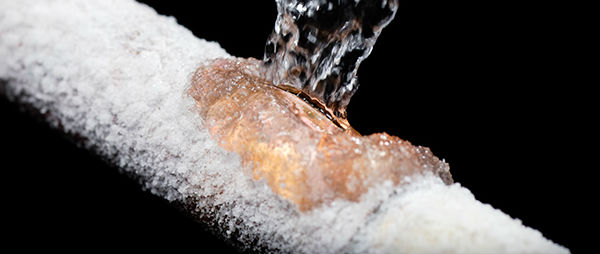Why do pipes that have never frozen before suddenly freeze now?
The snow protects our homes from the cold. It’s a crazy concept, but so true. The effect of having no snow to add that extra insulating layer is that our houses are subjected to more infiltration of cold air along the base and the rooflines.
There is another combination of variables that often causes pipes to freeze: super low temperatures coupled with strong winds. The wind drives that cold into homes. Houses that had no issues in the past suddenly have a frozen pipe disaster. One small break can lead to a completely flooded house!
The following are some ideas of what you can check on yourself and do to prevent a freeze-up from happening to you.
- Heat it up!
If your house starts to feel cold, chances are your pipes are getting cold too. Turn that heat on, and turn it up if the temperature really plummets. Especially for homes above a poorly insulated crawl space. The pipes in your crawlspace are more exposed than the ones in your home. By heating your house, you project heat through your floor and into the crawlspace. This may prevent a nasty freeze-up.
- Insulate with foam board.
If the crawl space is still chilly after turning up your heat, you might consider better insulation. Foam board is great for large surface areas in need of insulation. Foam board can be placed against wood walls and screwed into place with drywall screws. This cold weather barrier is fairly quick to install and easy to use for first-timers. Simply mark it using a carpenter's pencil, score down the line and snap off what you’ll need to create a barrier that will carry you through winter.
- Use a space heater.
If you’ve got some pipes that are unprotected, a space heater can be a good option. Use extreme caution, however, as they can be a fire hazard if used improperly. You do not need to make your pipes hot – the heater should simply be used to help heat the air space and keep it above 32 degrees Fahrenheit. Again, always make sure you avoid fire danger by keeping the heater clear of anything flammable.
- Keep your cabinets open.
When the temperature outside gets extremely low, it’s time to look at areas where there may not usually be a problem. Check under your kitchen and bathroom sinks. The warm air from your bathroom is cut off by the cabinet doors. If it feels really cold, the solution is simple. Open the cabinet doors and let in some of that warm air. Move anything you don’t want kids or pets to get to and leave these doors open until the temperatures warm up outside.
- Turn off the water.
Are you leaving town for an extended period of time with no one living in or watching your house? If you turn the water off to your home, it could still potentially freeze. Even if it does, there will be less water to fill the house. We have been to homes with broken pipes and water flowing until the neighbors called the fire department due to the “river” coming from the window! In that situation, the home had to be stripped to the studs because of the substantial amount of water that flooded the home. If the water had been turned off, the damage would have been contained to a much smaller area.
We hope you found these tips helpful! If you would like to discuss particular situations in your house please do not hesitate to call. We would be happy to help you figure out a tricky situation. We hope you’re prepared for the cold months ahead, but if you need us to be sure to get in touch!

